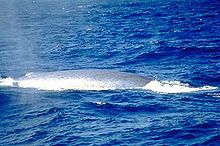😃😃Blue whale😃😃
ABOUT IT
The blue whale (Balaenoptera musculus) is a marine mammal belonging to the baleen whale suborder Mysticeti. Reaching a maximum confirmed length of 29.9 meters (98 feet) and weight of 173 tonnes (190 tons),[3] it is the largest animal known to have ever existed.[4] The blue whale’s long and slender body can be various shades of grayish-blue dorsally and somewhat lighter underneath.
There are currently five subspecies of blue whale, recognized by the Society for Marine Mammalogy's Committee on Taxonomy: B. m. musculus in the North Atlantic and North Pacific, B. m. intermedia in the Southern Ocean, B. m. brevicauda (the pygmy blue whale) in the Indian Ocean and South Pacific Ocean, B. m. indica in the Northern Indian Ocean, and B. m. unnamed subsp. in the waters off Chile. The blue whale diet consists almost exclusively of euphausiids (krill).
Morphology
Blue whales have long, slender mottled grayish-blue bodies, although they appear blue underwater.[14][15][16]
The mottling pattern is highly variable and the unique pigmentation pattern along the back in the region of the dorsal fin can be used to identify known individuals.Additional distinguishing features of the blue whale include a broad, flat head, which appears U-shaped from above; 270–395 entirely black baleen plates on each side of their upper jaw; 60–88 expandable throat pleats; long, slender flippers; a small (up to 13 inches (33 cm)) falcate dorsal fin positioned far back toward the tail; a thick tail stock; and a massive, slender fluke.
Size
The blue whale is the largest known animal.[24][14][25][26] In the International Whaling Commission (IWC) whaling database, 88 individuals longer than 30 m were reported, including one up to 33.0 m, but problems with how the measurements were made suggest that measurements longer than 30.5 m are somewhat suspect.[27] The Discovery Committee reported lengths up to 102 ft (31.1 m);[28] however, the longest scientifically measured (e.g., from rostrum tip to tail notch) individual blue whale was 98 ft (29.9 m).[3] Female blue whales are larger than males.[16][29] Hydrodynamic models suggest that a blue whale could not exceed 108 ft (33 m) due to metabolic and energy constraints.[30]
Life span
The most reliable age estimations are from ear plugs. Blue whales secrete earwax (cerumen) throughout their lives forming long, multilayered plugs. Each chronologically deposited light and dark layer (lamina) indicate a switch between fasting during migration and feeding, and one set is laid down per year, and thus the number of these layers can be used as an indicator of age.[35][36][37] The maximum age determined from earplug laminae for a pygmy whale is 73 years.
Reproduction and birth
Using the number of earwax lamina deposited in the earplug and development of sexual organs from dead whales,[57] it has been determined blue whales reach sexual maturity at about 10 years old and at an average length of 23.5 m for female Antarctic blue whales.[26][57][97][199][200] Another method for determining age at sexual maturity, involves measurements of testosterone from the baleen of male blue whales.[201][202] Testosterone concentrations measured from baleen suggest that the age at sexual maturity for one blue whale was 9 years.[201] Male pygmy blue whales averaged 61.4 ft (18.7 m) at sexual maturity.[203][204] Female pygmy blue whales are 68.9–71.2 ft (21.0–21.7 m) in length[31] and roughly 10 years old at age of sexual maturity.
Evolution
Blue whales are rorquals, in the family Balaenopteridae[266] whose extant members include the fin whale (Balaenoptera physalus), sei whale (Balaenoptera borealis), Bryde’s whale (Balaenoptera brydei), Eden's whale (Balaenoptera edeni), common minke whale (Balaenoptera acutorostrata), Antarctic minke whale (Balaenoptera bonaerensis), Omura's whale (Balaenoptera omurai), and humpback whale (Megaptera novaeangliae).[267]
Molecular evidence places blue whales in the Superorder Cetartiodactyla, which includes the Orders Cetacea (under which blue whales are classified) and Artiodactyla, even-toed ungulates. This classification is supported by evidence of morphological homology between cetaceans and artiodactyls in two described archaic whales.


HOPE YOU GOT AMUSED BY MY BLOG😃




blue whale is strong or shark is strong???....
ReplyDeletecomment down below.
I think blue whale is strong.
ReplyDelete